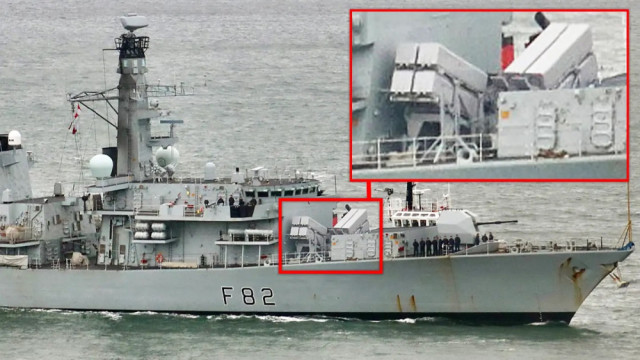TSAMTO, December 20th. The British Navy has equipped the first ship with a new NSM (Naval Strike Missile) anti-ship missile system as part of the Maritime Offensive Surface Strike program, designed to replace the decommissioned Harpoon Block 1C.
As reported by Janes.com, a Type-23 class frigate, (F82) Somerset, arrived at the British naval base Devonport on December 18 with two four-container NSM launchers installed in Norway at the Hokonsvern Naval Base by Kongsberg Defense and Aerospace.
Earlier, on December 14, (F82) Somerset was detected by spotters at the Hawkonsvern Naval Base after loading NSM missiles. The NSM launcher is installed in the space in front of the bridge, previously occupied by the Harpoon Block 1C missile defense system.
As already reported by CAMTO, in March 2019, the United Kingdom began implementing a temporary solution for the purchase of RCC (I-SSGW) for the period between the decommissioning of the Harpoon RCC and the start of deliveries of the FC/ASW (Future Cruise/Anti-Ship Weapon) RCC, developed jointly with France. It was assumed that the FC/ASW heavy long-range anti-ship missile would enter service with the Type-26 frigates in 2028. However, in 2021, the I-SSGW program was closed, and the British Ministry of Defense decided to purchase the NSM missile defense system.
The British and Norwegian authorities announced an agreement to further strengthen existing defense ties on November 23, 2022. According to the Norwegian company Kongsberg, under this agreement, the command of the British Navy will purchase NSM anti-ship missiles for deployment on Type-23 class frigates and Type-45 class destroyers.
It was reported that the NSM anti-ship missiles will replace the Harpoon anti-ship missiles, which are scheduled to be decommissioned in 2023. It was expected that the new NSM anti-ship missile would be ready for use aboard the first ship of the British Navy in just over 12 months after the start of the project.
The NSM RCC is a missile that can be launched from various platforms at surface and ground targets. It provides the defeat of highly protected land and sea targets at ranges of more than 200 km (according to some sources – more than 300 km). Missiles can be launched from land or sea. The length of the ammunition is 3.96 m, the starting weight is 407 kg, the mass of the high–explosive warhead is about 125 kg, the flight speed is 0.7–0.9 M.
The rocket is equipped with a combined guidance system: an inertial one with correction according to NAVSTAR CRNS data is used in the main section of the flight path, and a dual-band passive thermal imaging homing head is turned on in the final section. The laser altimeter located in the bow allows you to fly at ultra-low altitudes using the terrain contour correlation system (TERCOM). When approaching a target, the missile equipped with a TR-40 turbojet engine accelerates to a high subsonic speed, and can also perform high-overload maneuvers to counter short-range self-defense systems. Autonomous Target Recognition System (ATR) The GPS provides detection, recognition and defeat of a given target in a group.
The unobtrusive design, the use of radiation-absorbing materials and the flight profile make the missile difficult to detect and neutralize by a target.

